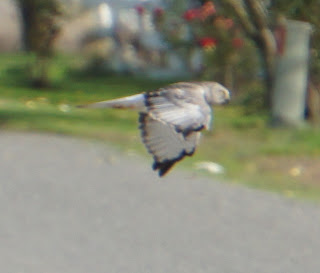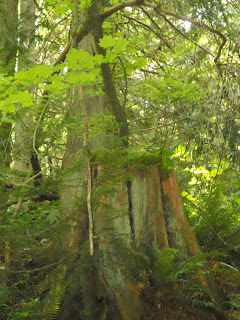On November 3rd, I headed south of Bellingham along Chuckanut Drive. I stopped at Larabee State Park and observed a migrating Merlin falcon for 50 minutes, then I continued down through Bow and Edison to Bay View. On Bay View Road I got quite a show of Red-Tailed Hawk and Northern Harrier activity, plus a Perched Rough-Legged Hawk. Bald Eagles were not in evidence.
Red-Tailed Hawks are by far the most common large (Buteo) hawk in our region. Many times they get mistaken for other hawks, because they are so variable in coloration. Perhaps this is because there are three subspecies that appear in our county: the 'Western' regularly, and the 'Harlans' and 'Alaskan', occasionally. Furthermore, there are sometimes intergrades when they cross mate. Then there is the 'Gloger's Rule' which notices a tendency for more northern members of a bird species to have darker pigments.
Another thing which can confuse beginning 'birders' is that immature Red-Tails do not have red tails, but dingy brown retrices. The second picture is a juvenile and the third photo is an adult who has a partly amputated wing, so is 'retired' from the raptor business and is not in the education business. Notice it has the mature red tail.
Red-Tailed Hawks vary from almost pure white to almost fully dark, so how can you identify them? One way is the dark patch on the leading edge of the upper wing (the patagium). A second 'tell' is the dark belly-band. Other ways I identify when they are at a distance is by perch stance, flight type, and their strong head profile. When they fly, they make several strong wing strokes followed by a glide. They are also great at soaring on updrafts.
Red-Tailed Hawk
Buteo jamaicensis
young Red-Tailed Hawk
Mature Red-Tailed Hawk
(non-releasable resident at Sardis Raptor Center)
Note the dark belly-band.
At Larabee State Park I saw this small, male Merlin perched at the top of a dead Sitka Spruce. He was ignoring fly-by songbirds and by the crop size, was quietly digesting a meal. This was not one of the local 'Black Merlins' (Falco columbarius suckleyi). They are much darker...so much so that the black malar mark (mustache) below the eyes is obscured. You can clearly see the malar mark on this guy.
Male Taiga Merlin (aka Boreal Merlin)
Falco columbarius columbarius
The scapulars on Taiga Merlins are often slate colored or slightly bluish, if the light hits them right. Taigas like this one summered in Alaska and will make their way down to Central America or even northern South America for the winter.
After watching him from 11:00 to 11:47, he looked directly at me, muted, spread his tail, head bobbed, and took flight to the south. Of course, he knew of my presence the whole time and when he was ready to leave, we made eye contact, across 50 meters.
Merlin profile
(Note the distinctive head profile.)
Adult Male Northern Harrier
Circus cyaneus
Rough-Legged Hawk
Buteo lagopus
(Perched 300 meters away)
Finally, perched above Bayview Road in the middle of the agricultural valley, I saw this Rough-Legged Hawk. They are much less frequently seen than the Red-Tailed Hawks. They are called 'rough-legged' because their legs are sheathed in feathers, above the feet. You can see the dark feathers of this dark morph bird. Its upper parts were mottled, but its belly was almost black. After watching it perch and preen for about twenty minutes, it suddenly stooped on something in the adjacent field... probably a vole or mouse.































































